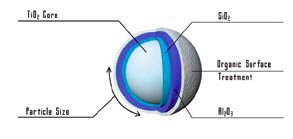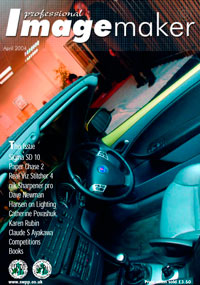articles/Paper/layingtrail-page6
Paper Chase - Laying the Trail - part 6 of 1 2 3 4 5 6 7 8 9 10
by Mike McNamee Published 01/04/2004

:The complexity of a Titanium Dioxide filler powder. This one from DuPont has five layers like an onion shell but each is a different material. The ability to make such complex spheres only 20 nanometres in diameter leads to the name nanoporous.
One of the most noticeable effects of ink absorption is the difference between a fine art paper and a gloss paper. A Somerset Velvet paper will absorb ink into its substrate to such an extent that it will be as much as 7% lighter as a Hahnemuhle Photo Rag. A gloss paper will leave the ink very close to the surface and may produce a black which is another 10% darker again. This is not necessarily to imply that one product is better than another. There are those who hold that on of the advantages of Somerset is that the ink is better protected in the body of the paper and also that the paper will not flood with ink at high inking levels, enabling more depth of colour to be obtained. When preparing a sample for fade testing the astute print-maker will try for as much ink as possible as this will deliver a better Blue Wool Rating. One advantage of RIPs is that the total ink limit can be adjusted.

The Meaning of Errors
The issue that you now have to wrestle with is that a 300% improvement in the statistics does not always make a print 3 times better looking, because you may be talking of small improvements on data that are already quite good! We have had examples during our seminars of inkjets producing work that is commercially acceptable and judged to be "OK" by the majority of observing photographers. However the statistics of some of these examples has been poor. The main problems arise when prints have to be matched as "repeats" or additions to an album. Suddenly the viewer has a reference to compare with and the differences become all too apparent. The same problems arise when mixtures of digital and conventional prints are assembled in the same album, especially if this mix is of in-house printed and externally lab-printed pictures. We are reluctant to point any fingers but we have been shown (and measured) examples of so-called matched prints, which are woefully inaccurate. We can even give you the figures - the "matched" print was 16 Delta E away from the reference sample. To put this in perspective, contract-proofing standards are normally agreed between 4 and 7; on the same scale and we expect to get the whole gamut inside about 10 every time in our day to day work. The matched print looked awful and measured awful but was still sent back to the photographer.
The upshot of the discussion is this - you are quite likely to get acceptable sets of prints without spending any additional money having colour calibration carried out. If you have to match prints between your lab and your own inkjet printer or between yourself and your commercial (4-colour process) printer or match prints with other organisations (e.g. for proofing approval) you are going to have to be profiled. How much effort you expend will depend upon what you are doing. If you only have to match a couple of prints, and you have the job under control at your end, you can match by eye and make a few extra test prints when needed. If your reputation hangs on it or you are regularly going to press then you will have to work at proofer standards.
Please Note:
There is more than one page for this Article.
You are currently on page 6
- Paper Chase - Laying the Trail page 1
- Paper Chase - Laying the Trail page 2
- Paper Chase - Laying the Trail page 3
- Paper Chase - Laying the Trail page 4
- Paper Chase - Laying the Trail page 5
- Paper Chase - Laying the Trail page 6
- Paper Chase - Laying the Trail page 7
- Paper Chase - Laying the Trail page 8
- Paper Chase - Laying the Trail page 9
- Paper Chase - Laying the Trail page 10
1st Published 01/04/2004
last update 09/12/2022 14:55:40
More Paper Articles
There are 0 days to get ready for The Society of Photographers Convention and Trade Show at The Novotel London West, Hammersmith ...
which starts on Wednesday 15th January 2025





